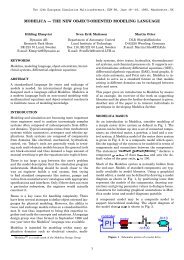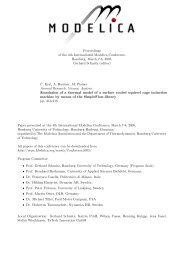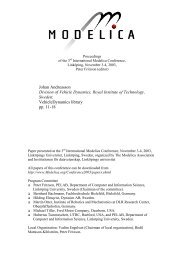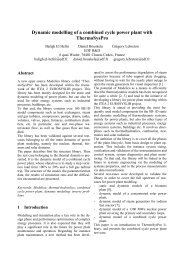Integration of CasADi and JModelica.org - Automatic Control
Integration of CasADi and JModelica.org - Automatic Control
Integration of CasADi and JModelica.org - Automatic Control
You also want an ePaper? Increase the reach of your titles
YUMPU automatically turns print PDFs into web optimized ePapers that Google loves.
tended for compilation <strong>and</strong> linking with numerical<br />
solvers. While this is a well established procedure<br />
for compiling Modelica models, it suffers from some<br />
drawbacks. Compiled code indeed <strong>of</strong>fers very efficient<br />
evaluation <strong>of</strong> the model equations, but it also requires<br />
the user to regard the model as a black box. In contrast,<br />
there are many algorithms that can make efficient<br />
use <strong>of</strong> models expressed in symbolic form. Examples<br />
include tools for control design, optimization algorithms,<br />
<strong>and</strong> code generation, see [12] for a detailed<br />
treatment <strong>of</strong> this topic. In order to <strong>of</strong>fer an alternative<br />
format for model export, <strong>JModelica</strong>.<strong>org</strong> supports<br />
the XML format described in [32]. This format is an<br />
extension <strong>of</strong> the XML scheme specified by the Functional<br />
Mock-up Interface (FMI) specification [29] <strong>and</strong><br />
contains, apart from model meta data also the model<br />
equations. The equations are given in a format that is<br />
closely related to the expression trees that are common<br />
in compilers. The XML export functionality is explored<br />
in this paper to integrate the packages ACADO<br />
Toolkit <strong>and</strong> <strong>CasADi</strong> with the <strong>JModelica</strong>.<strong>org</strong> platform.<br />
2.4 ACADO Toolkit<br />
ACADO Toolkit [26] is an open-source tool for automatic<br />
control <strong>and</strong> dynamic optimization developed<br />
at the Center <strong>of</strong> Excellence on Optimization in Engineering<br />
(OPTEC) at the K.U. Leuven, Belgium. It<br />
implements among other things Bock’s direct multiple<br />
shooting method [10], <strong>and</strong> is in particular designed to<br />
be used efficiently in a closed loop setting for nonlinear<br />
model predictive control (NMPC). For this aim, it<br />
uses the real-time iteration scheme, [14], <strong>and</strong> solves<br />
the NLP by a structure exploiting sequential quadratic<br />
programming method using the active-set quadratic<br />
programming (QP) solver qpOASES, [18].<br />
Compared to other tools for dynamic optimization,<br />
the focus <strong>of</strong> ACADO Toolkit has been to develop a<br />
complete toolchain, from the DAE integration to the<br />
solution <strong>of</strong> optimal control problems in realtime. This<br />
vertical integration, together with its implementation<br />
in self-contained C++ code, allows for the tool to be<br />
efficiently deployed on embedded systems for solving<br />
optimization-based control <strong>and</strong> estimation problems.<br />
3 <strong>CasADi</strong><br />
<strong>CasADi</strong> is a minimalistic computer algebra system implementing<br />
automatic differentiation, AD (see [22]) in<br />
forward <strong>and</strong> adjoint modes by means <strong>of</strong> a hybrid symbolic/numeric<br />
approach, [4]. It is designed to be a low-<br />
level tool for quick, yet highly efficient implementation<br />
<strong>of</strong> algorithms for numerical optimization, as illustrated<br />
in this paper, see Section 4. Of particular<br />
interest is dynamic optimization, using either a collocation<br />
approach, or a shooting-based approach using<br />
embedded ODE/DAE-integrators. In either case,<br />
<strong>CasADi</strong> relieves the user from the work <strong>of</strong> efficiently<br />
calculating the relevant derivative or ODE/DAE sensitivity<br />
information to an arbitrary degree, as needed<br />
by the NLP solver. This together with an interface<br />
to Python, see Section 3.1, drastically reduces the effort<br />
<strong>of</strong> implementing the methods compared to a pure<br />
C/C++/Fortran approach.<br />
Whereas conventional AD tools are designed to be<br />
applied black-box to C or Fortran code, <strong>CasADi</strong> allows<br />
the user to build up symbolic representations <strong>of</strong><br />
functions in the form <strong>of</strong> computational graphs, <strong>and</strong><br />
then apply the automatic differentiation code to the<br />
graph directly. These graphs are allowed to be more<br />
general than those normally used in AD tools, including<br />
(sparse) matrix-valued operations, switches <strong>and</strong><br />
integrator calls. To prevent that this added generality<br />
comes to the cost <strong>of</strong> lower numerical efficiency,<br />
<strong>CasADi</strong> also includes a second, more restricted graph<br />
formulation with only scalar, built-in unary <strong>and</strong> binary<br />
operations <strong>and</strong> no branches, similar to the ones found<br />
in conventional AD tools.<br />
<strong>CasADi</strong> is an open source tool, written as a selfcontained<br />
C++ code, relying only on the st<strong>and</strong>ard template<br />
library.<br />
3.1 Python interface to <strong>CasADi</strong><br />
Whereas the C++ language is highly efficent for high<br />
performance calculations, <strong>and</strong> well suited for integration<br />
with numerical packages written in C or Fortran,<br />
it lacks the interactivity needed for rapid prototyping<br />
<strong>of</strong> new mathematical algorithms, or applications <strong>of</strong> an<br />
existing algorithm to a particular model. For this purpose,<br />
a scripting language such as Python, [36], or a<br />
numerical computing environment such as Matlab, is<br />
more suitable. We choose here to work with Python<br />
rather than Matlab due to its open source availabiliy<br />
<strong>and</strong> ease <strong>of</strong> interfacing with other programming languages.<br />
Interfacing C++ with Python can be done in several<br />
ways. One way is to wrap the C++ classes in<br />
C functions <strong>and</strong> blend them into a Python-to-C compiler<br />
such as Cython. While this approach is simple<br />
enough for small C++ classes, it becomes prohibitively<br />
cumbersome for more complex classes. Fortunately,<br />
there exist excellent tools that are able to automate
















